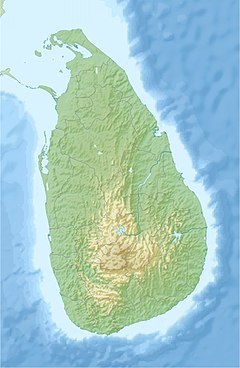Nagerkovil school bombing
| Nager Kovil school bombing | |
|---|---|
| Location | Nagar Kovil, Sri Lanka |
| Coordinates | 9°42′02″N 80°18′31″E / 9.70056°N 80.30861°E |
| Date | September 22, 1995 (+6 GMT) |
| Target | Sri Lankan Tamils |
Attack type | Aerial bombardment |
| Weapons | Bomb |
| Deaths | 71 [1] |
| Injured | Unknown but many |
| Perpetrators | Sri Lankan Airforce |
The Nager Kovil school bombing refers to a disputed incident in the Sri Lankan Civil War. Tamil sources claim that on September 22, 1995, the Sri Lankan Air Force bombed the Nagar Kovil Maha Vidyalayam school in Jaffna, resulting in the death of, by varying accounts, 34-71 Sri Lankan Tamil civilians, primarily schoolchildren and the injury of many more. The Sri Lankan government denied bombing the school.[2] Journalists and human rights organizations reported the imposition of censorship at the time of the alleged incidents.[3]
Accounts and reactions
University Teachers for Human Rights (Jaffna)
According to University Teachers for Human Rights (UTHR), a Jaffna-based organization, the staff of Nagarkovil Government School noticed bomber activity by the Sri Lanka Air Force around the school the morning of Friday, September 22, 1995. Several children who had come out of school had sheltered under a tree, waiting for the bombers to leave. About 12:45 pm a bomb fell near the tree, instantly killing 39 and injuring others. The injured continued to die on subsequent days.[4]
Human Rights Watch
The 1996 HRW annual country report described "a major offensive on the Jaffna peninsula" by the Sri Lankan government which began on September 22, and which included curbs on war-related reporting by both the domestic and international press. "Among the first stories to be subjected to these censorship requirements were reports that on September 21 and 22, heavy shelling and aerial attacks by government forces on the northern Jaffna region had killed some seventy civilians, including many school children." Human Rights Watch also cited a Reuters report from September 23 that the army had denied the incident and that the story had been "subjected to military censors, who deleted quotes from civilians on the reported deaths of twenty children."[3]
Australian Foreign Ministry
In a letter of October 6, 1995, the Australian government expressed a concern about "tragic incidents where non combatant Tamil civilians have been killed in military exchanges," mentioning "the reported deaths of 44 school children when a school was allegedly bombed at the village of Nagarkovil on September 22."[5]
References
- ^ "Tamil Nation and Beyond".
- ^ "Navy assault on fishermen". Sri Lanka monitor. Archived from the original on 2003-06-12. Retrieved 2006-01-08.
- ^ a b "Human Rights Development - Sri Lanka". HRW. Retrieved 2006-01-11.
- ^ "1995 UTHR report". UTHR. Retrieved 2006-01-11.
- ^ "Australian Foreign Ministry to the Swiss Federation of Tamil Associations". Tamilnation. Retrieved 2006-01-14. [dead link]
External links
- 1995 crimes in Sri Lanka
- Aerial bombing in Sri Lanka
- Attacks on buildings and structures in Sri Lanka
- Attacks on civilians attributed to the Sri Lanka Air Force
- Civilian massacres in Sri Lanka
- Mass murder in 1995
- Mass murder of Sri Lankan Tamils
- School bombings
- School massacres
- September 1995 events in Asia
- Sri Lankan government forces attacks in Eelam War III
- Terrorist incidents in Sri Lanka in 1995

